

Innovators Under 35.
Collaboration. Design. 3 Simple Words to Revolutionize the World. Imitation is what makes us human and creative – Kat McGowan. Imitation might be a form of flattery, but it is also a good way to end up in legal trouble.

More than 6,000 lawsuits over patent infringements were filed in the United States last year. The Future of Organization — Deep Code. Human organizational models have long been limited to a small set of effective approaches.
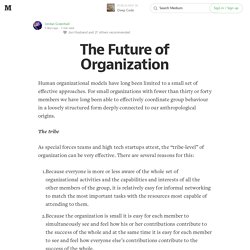
For small organizations with fewer than thirty or forty members we have long been able to effectively coordinate group behaviour in a loosely structured form deeply connected to our anthropological origins. The tribe As special forces teams and high tech startups attest, the “tribe-level” of organization can be very effective. If Incremental Innovation Dominates then We Lose the Future. If one type of innovation prevails and begins to dominate, the incremental one, the risks of not providing for a healthy future increases, we are in the throes of ossifying our innovation.
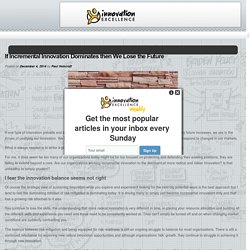
We begin to lose our abilities to be responsive and flexible. We lose our agility to respond to changes in our markets. What is always needed is to strike a good balance in our innovation portfolio, between the immediate and the future. For me, it does seem far too many of our organizations today might be far too focused on protecting and defending their existing positions, they are failing to extend beyond a core. Are our organizations working incremental innovation to the detriment of more radical and riskier innovation? I fear the innovation balance seems not right Of course the strategic view of sustaining innovation while you explore and experiment looking for the next big potential wave is the best approach but I tend to feel the dominating mindset of risk mitigation is dominating today. Re-inventing Innovation at Cisco? Embrace Openness, Small Companies!
“We believe one of the key strategies for reinventing innovation at Cisco is to embrace openness.”
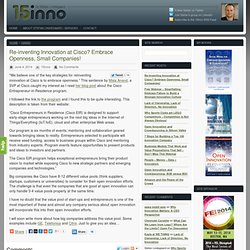
This sentence by Mala Anand, a SVP at Cisco caught my interest as I read her blog post about the Cisco Entrepreneur-in-Residence program. I followed the link to the program and I found this to be quite interesting. The Secret to Creativity, Intelligence, and Scientific Thinking: Being Able to Make Connections. 10.3K Flares Filament.io 10.3K Flares × When we shared this image from the @buffer Twitter account recently, it got me thinking.
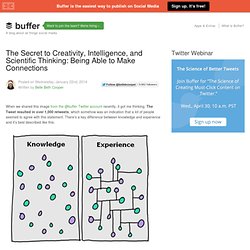
The Tweet resulted in over 1,000 retweets, which somehow was an indication that a lot of people seemed to agree with this statement. There’s a key difference between knowledge and experience and it’s best described like this: The original is from cartoonist Hugh MacLeod, who came up with such a brilliant way to express a concept that’s often not that easy to grasp. The secret to creativity, intelligence and scientific thinking: Being able to make connections.
The World's Most Innovative Companies 2014. If you Google the phrase "faith-based businesses," the results point to companies that pursue a religious agenda.
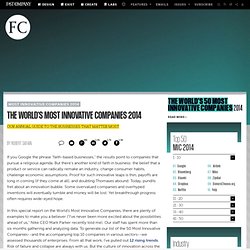
But there's another kind of faith in business: the belief that a product or service can radically remake an industry, change consumer habits, challenge economic assumptions. Proof for such innovative leaps is thin, payoffs are long in coming (if they come at all), and doubting Thomases abound. Today, pundits fret about an innovation bubble. Some overvalued companies and overhyped inventions will eventually tumble and money will be lost. Yet breakthrough progress often requires wide-eyed hope. 5 Steps to Build a Creative Business from Scratch. Image credit: Shutterstock Any economist will tell you that the creative sector is a leading component of worldwide economic growth, employment and trade.
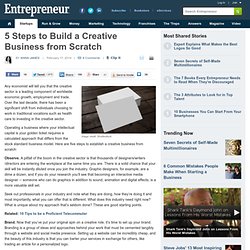
Over the last decade, there has been a significant shift from individuals choosing to work in traditional vocations such as health care to investing in the creative sector. Operating a business where your intellectual capital is your golden ticket requires a calculated approach that differs from the stock standard business model. "Real" Sustainability: The New Disruptors. By scaling up social enterprise solutions, corporations can promote real sustainability and CSR.
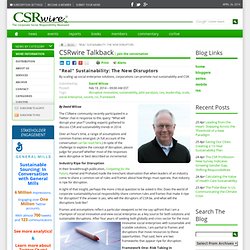
By David Wilcox The CSRwire community recently participated in a Twitter chat in response to this query: “What will disrupt your year?” Leading experts gathered to discuss CSR and sustainability trends in 2014. Most Innovative Companies 2014. Innovation Sighting: Task Unification Saves Lives & Money. Philips North America announced Fosmo Med, developer of the Maji Intravenous (IV) saline bag, as the grand prize winner of the first-ever Philips Innovation Fellows competition, revealing the technology as the next big, meaningful innovation in health and well-being.
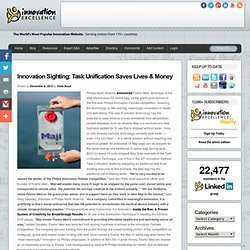
The new IV solution technology has the potential to save millions of lives worldwide from dehydration-related diseases, such as cholera. Defining Innovation in One Word. MentorEdge’s Ravi Kikan (India) posted this challenge on the Future Trends LinkedIn group discussion page.
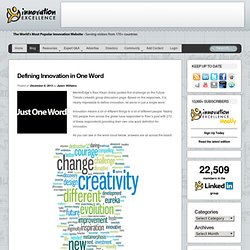
Based on the responses, it is nearly impossible to define innovation, let alone in just a single word. Top 10 Innovations 2013. Despite formidable odds, this year was a good one for life science innovation. The double punch of the government-wide belt tightening, known as the sequester, and the two-week federal government shutdown deflated institutional budgets and sowed uncertainty among investors. But new and exciting products still made their way into the marketplace. Maturing Innovation Management One Step at a Time.
The fall conference season is winding down and this year I've had the privilege of attending and speaking at some great innovation events, sharing the newly launched Innovation Management Maturity Model™. From regional PDMA meetings in Dallas and Atlanta, to the national PDMA PIM conference, the Optimizing Innovation conference in NYC, to the Planview Horizons Annual Customer Conference, it's been a brain-filling couple of months. In sharing the Innovation Management Maturity Model with conference attendees, there were two common questions: “What is it?” And, “How does it compare with PDMA’s new Innovation Management Standard?” Great questions! The Innovation Management Maturity Model. How Diversity Can Drive Innovation. Most managers accept that employers benefit from a diverse workforce, but the notion can be hard to prove or quantify, especially when it comes to measuring how diversity affects a firm’s ability to innovate.
But new research provides compelling evidence that diversity unlocks innovation and drives market growth—a finding that should intensify efforts to ensure that executive ranks both embody and embrace the power of differences. In this research, which rests on a nationally representative survey of 1,800 professionals, 40 case studies, and numerous focus groups and interviews, we scrutinized two kinds of diversity: inherent and acquired.
Stop Me Before I “Innovate” Again! - Bill Taylor. By Bill Taylor | 8:00 AM December 6, 2013 The Wall Street Journal is out with a funny (and brutally honest) takedown of a word that has achieved almost-mythical status among business thinkers like me. That word is innovation, and it’s quickly losing whatever meaning it once had. Journal writer Dennis Berman begins by citing Kellogg CEO John Bryant, the respected head of a well-run company, who was describing one of its “innovations” for 2013. Systematic innovation: what it is and who should take responsibility. Innovation and business: why you can’t ignore it. A few months ago, a senior HR person called up Inventium’s office asking to find out more about how we could help his organisation, a household name in the food industry, drive innovation.
Why businesses need coaches. “We want to be innovative” is a catch cry of most Australian organisations. Little wonder. Australian companies are among the least proficient innovators in the OECD and seem to fail at creating the conditions needed for innovation to flourish. Hit the high notes: Lessons on business innovation from soprano singer Tania de Jong. Innovation Stalled? Bad Culture Defeats Good Strategy. Innovation 1000 Study.